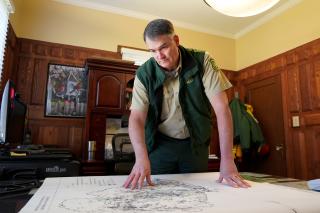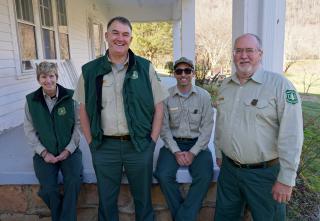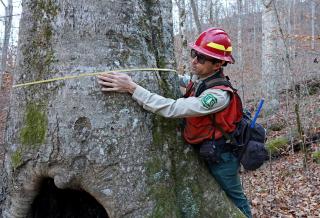The little district that could: Making big impacts with a small staff

KENTUCKY—The steep slopes, deep ravines and remains of historic resource extraction make the Redbird Ranger District in the Daniel Boone National Forest a challenging landscape to manage.
As one of the youngest districts in the Forest Service system, the 145,850-acre unit in southeastern Kentucky has also faced the challenge of building relationships and providing opportunities among some of the lowest median household income counties in the country.
Though the district is small, with only 15 permanent employees, it has met the needs of a rural, underserved region of the country and enhanced the landscape’s resilience by building partnerships, seeking innovative solutions and embodying Forest Service values.
“We still have families here that remember before the Forest Service [managed these lands],” said Redbird District Ranger Bobby Claybrook. “There are challenges with being the ‘new kid on the block,’ but there are also so many opportunities to have a positive impact.”
To improve wildlife habitat and address wildfire risk in an area with abundant wildland-urban interface conditions, the district signed a decision memo to increase the prescribed burning acre availability to cover approximately 75% of the unit.
Through a grant from the Rocky Mountain Elk Foundation, the district has carried out forest management work on over 40 acres of reclaimed abandoned mine lands in an identified elk management zone. This work will continue to support wildlife habitat improvement activities in a unit deemed a high wildlife habitat priority by both the foundation and state partners.
The district also hosted a visit with Southern Region Timber Program team members to identify alternative harvesting methods for steep slopes. Alternative harvesting methods like tethered logging, which uses cable winch systems, will provide new tools for the agency to preserve the historically and economically vital timber industry as well as the environmental sustainability of agency land management practices.
“Logging is a huge natural resource benefit to our local communities,” said Claybrook. “As the coal industry has shifted away from this area, the jobs we support in the timber industry, or even recreation and tourism, are becoming more and more important.”
The district has continued to prioritize projects that enhance the vitality of the forest and its neighboring communities. Through the unit’s work to expand vehicle width allowances on the popular Redbird Crest Trail and a recent agreement with the Kentucky Mountain Regional Recreation Authority, they have enhanced access to off-highway vehicle routes and trails that are the heart of the area’s tourism economy. The agreement establishes the foundation for future cooperation on sections of the First Frontier Appalachian Trails system that will overlap forest land. The planned trail system is planned to connect 16 counties in the area and increase economic development, tourism and outdoor recreation for residents and visitors.
“Ultimately, it’s about building relationships,” said Claybrook. “We want to do right by the lands we manage and the communities we serve and that works best when you build relationships that connect people to the land.”
In addition to their work to support local tourism and timber economies, the unit has supported its local communities in more individual ways. They established a working relationship with the Frenchburg Job Corps Center to allow students to gain valuable work experience in the field and in the office. They’ve also built relationships with local partners, like the Clay County Historical Society, to share in historic preservation work and enhance local connections to the land.
“Strong partnerships are vital to the forest’s overall success,” said H. Scott Ray, forest supervisor for the Daniel Boone National Forest. “The district staff has done a fantastic job working with the local communities. I applaud the outstanding work by the team on the Redbird District. As we look to the future, I see the Redbird continuing to enhance local economies and enhance access to nature in this beautiful part of the country.”


